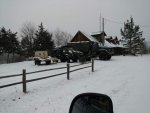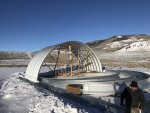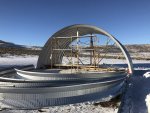- 3,386
- 1,433
- 113
- Location
- The actual midwest, NM.
Peakbagger, I re-read lots of your useful advice in old posts last night, in an effort to learn about the common issues, and hopefully pin down more precisely what's going on in this case.
Known is that this SEE ran just fine a few months ago (but it was warmer then, if that can factor in) and that the line from the strainer to the late style primer pump was replaced when I got it, as was the tank sending unit. Also known is that the tank was full of crap - both liquid and solids.
Not much dirt in the strainer (more on that later) and very little in the bottom of the filter canisters when I changed filters yesterday.
Blew out the section from the valve to the tank with compressed air, thinking that the inlet could've been plugged. Lots of bubbles in the tank, so no stoppage there.
The connection to the strainer could be rotated, so put a split hose and hose clamp over that. Tightened the clamps at the tank. Checked all other connections for tightness.
One of the two main things I'll try today is removing the front bleeder screw. It turns, but won't move in or out. If it can be removed, I'll drill and tap for a new bolt (with the canister removed, of course). It's probably stripped, so air could get in there, even if I can't make fuel come out.
The other is to put a suitable size O-ring in as a gasket for the strainer cup. If I have one. Might have to use gasket material instead.
And while on the subject of the strainer, after having blown the incoming line out, there has been lots of debris in the strainer cup after each starting attempt.
If I can get it started, I'll momentarily pull the drain plug on the tank to flush out more crap, but if it won't start...
My guess is that enemy number one is the bleeder screw. And if the removal attempts continue to fail I'll replace the filter holder assembly. Which means removing the gizmo on top of it. What the heck is that little "box" with fuel and two wires going to it??
Then, after all else fails, I'll go asking around in the neighborhood for a boat tank to borrow.
And, yes, the knowledge would be easier to find if we had a "FLU bugs" thread, with subcategories such as electrical, fuel, hydraulics, etc.
Known is that this SEE ran just fine a few months ago (but it was warmer then, if that can factor in) and that the line from the strainer to the late style primer pump was replaced when I got it, as was the tank sending unit. Also known is that the tank was full of crap - both liquid and solids.
Not much dirt in the strainer (more on that later) and very little in the bottom of the filter canisters when I changed filters yesterday.
Blew out the section from the valve to the tank with compressed air, thinking that the inlet could've been plugged. Lots of bubbles in the tank, so no stoppage there.
The connection to the strainer could be rotated, so put a split hose and hose clamp over that. Tightened the clamps at the tank. Checked all other connections for tightness.
One of the two main things I'll try today is removing the front bleeder screw. It turns, but won't move in or out. If it can be removed, I'll drill and tap for a new bolt (with the canister removed, of course). It's probably stripped, so air could get in there, even if I can't make fuel come out.
The other is to put a suitable size O-ring in as a gasket for the strainer cup. If I have one. Might have to use gasket material instead.
And while on the subject of the strainer, after having blown the incoming line out, there has been lots of debris in the strainer cup after each starting attempt.
If I can get it started, I'll momentarily pull the drain plug on the tank to flush out more crap, but if it won't start...
My guess is that enemy number one is the bleeder screw. And if the removal attempts continue to fail I'll replace the filter holder assembly. Which means removing the gizmo on top of it. What the heck is that little "box" with fuel and two wires going to it??
Then, after all else fails, I'll go asking around in the neighborhood for a boat tank to borrow.
And, yes, the knowledge would be easier to find if we had a "FLU bugs" thread, with subcategories such as electrical, fuel, hydraulics, etc.





![DSCN0074[1].jpg DSCN0074[1].jpg](https://www.steelsoldiers.com/data/attachments/451/451855-e09667f0b104ef9185332d115d463951.jpg)
![DSCN0075[1].jpg DSCN0075[1].jpg](https://www.steelsoldiers.com/data/attachments/451/451856-507b831fbd92b6f41614ef2d938a8f2f.jpg)
![DSCN0077[1].jpg DSCN0077[1].jpg](https://www.steelsoldiers.com/data/attachments/451/451857-b5164ce9742252ebc7858a97029a0418.jpg)